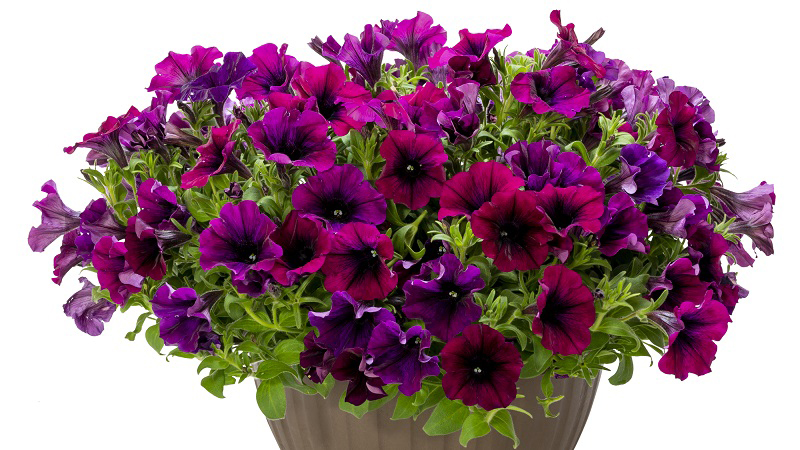Greenhouse Lighting for Long Days

The classic pie plate reflector and incandescent light bulb has been updated with the newer light-emitting diode (LED) flowering lamps, as seen above. These low-intensity LEDs can be screwed into the same fixture as incandescent bulbs, are available in different spectral combinations, and have a long-lasting luminous lifespan. Photo: Christopher J. Currey
Since many crops have photoperiodic flowering and/or dormancy responses, it is important to be able to control those responses — including inhibiting or inducing flowering — to follow production schedules and finish crops at the right time. This article will focus on the key points for long-day lighting in greenhouses, and provide several best management practices for photoperiodic lighting.
What Is a “Long” Day?
What is considered a “long” day? The answer is, “It depends.” The difference between a long and short day is based on the critical photoperiod, which varies among species. For plants with a short-day photoperiodic flowering response, the critical photoperiod is defined as the photoperiod at or below which flowering occurs. Alternatively, for plants with a long-day photoperiodic flowering response, the critical photoperiod is the photoperiod at or above which flowering occurs.
There is a tendency to think of days longer than 12 hours as long and days shorter than 12 hours as short. While some popular flowering potted plant species such as poinsettia and kalanchoe (both short-day plants) have critical photoperiods around 12 or 12.5 hours, there is much more variation across short- and long-day plants. For instance, there are some short-day plants where 14 hours is considered a short-day and will induce flowering, while that same 14-hour day may also be considered long for some long-day plants and will induce flowering.
Lighting for Long-Day Growing
When the days are naturally short, the only way to create long days in the greenhouse is to use day-extension or night-interruption lighting. Day-extension is the creation of long-day conditions by using lighting to extend the day or photoperiod. While it may be more traditional to start lighting at the end of the day, extending the day into the evening, lighting can also be used before sunrise to extend the day. How lights need to operate depends on the specific crop. It goes back to the concept of critical daylengths, and lights need to operate long enough to create a photoperiod sufficiently long to inhibit short-day responses or promote long-day responses. Since critical photoperiods can vary widely, it is common to use 16 hours as a target daylength, as this is going to be a “long day” for most greenhouse crops.
Night-interruption lighting is the other long-day lighting strategy. In contrast to day-extension lighting, night-interruption is the use of lighting in the middle of the night to interrupt the dark period. Although we frequently talk about the daylength or photoperiod and flowering or dormancy responses, it is the uninterrupted dark period that induces responses. Short-day responses are actually long-night responses; similarly, long-day responses are short-night responses. The duration of night-interruption lighting depends on the critical photoperiod and how short the night needs to be. While one or two hours of night-interruption lighting may be enough to simulate dark periods short enough to get long-day responses, using four hours of light is most common because this ensures long-day responses for nearly all crops grown in greenhouses. In addition to lighting for a long enough time, it is also important to apply it at the right time — which is usually the middle of the night (10 p.m. to 2 a.m.).
The Right Tools for the Job
Not all light is created equally and, as a result, not all light sources are appropriate for long-day lighting. Both light intensity and light quality are important for effectively creating long day conditions. With respect to light intensity, 2 µmol·m–2·s–1 or 10 foot-candles is the minimum required intensity. Below this, plants may not perceive the lighting and it may be ineffective. Light intensities above this can be used, but are not necessarily needed, as higher light intensities won’t elicit a stronger response.
In addition to providing sufficient light intensity, lights need to provide the appropriate quality or spectra of light to be effective. If one is only interested in short-day plants and inhibiting their flowering, red light is an effective wavelength. However, we want our lighting to be applicable to both short- and long-day plants. As a result, both red and far-red light are required, since long-day plants have the additional requirement of far-red light. While you may associate far-red light with stem elongation, it is also a key wavelength for flower induction in long-day plants.
There are several different lights that can be used for long-days. The traditional choice for photoperiodic lighting is the incandescent bulb. However, incandescent bulbs are being phased out due to their inefficient conversion of energy to light and won’t be an option for much longer. The development of “flowering lamp” light-emitting diodes (LEDs) are a great replacement. These lamps are built to be compatible with the same fixtures that incandescent bulbs used, and they are available with the appropriate combinations of red and far-red light that crops require.
There are other lights that can be used for photoperiodic lighting. For instance, traditional high-pressure sodium (HPS) lamps are certainly effective, but it may be overkill at the density they are installed for supplemental or photosynthetic lighting. Alternatively, fewer HPS lamps can be used to reduce energy costs so long as 2 µmol·m–2·s–1 or 10 foot-candles are provided to the crop canopy. There are also HPS lamps with oscillating reflectors, allowing a single fixture to scatter sufficient light across a much wider area than numerous low- intensity LEDs bulbs.
Don’t Be Left in the Dark
Controlling flowering is a critical component of greenhouse floriculture crop production. This is especially true for spring crop production where so many annual and perennial species have a long-day flowering requirement. Hopefully, these best management practices for long-day lighting will help you design and maintain effective lighting strategies for your greenhouse.









